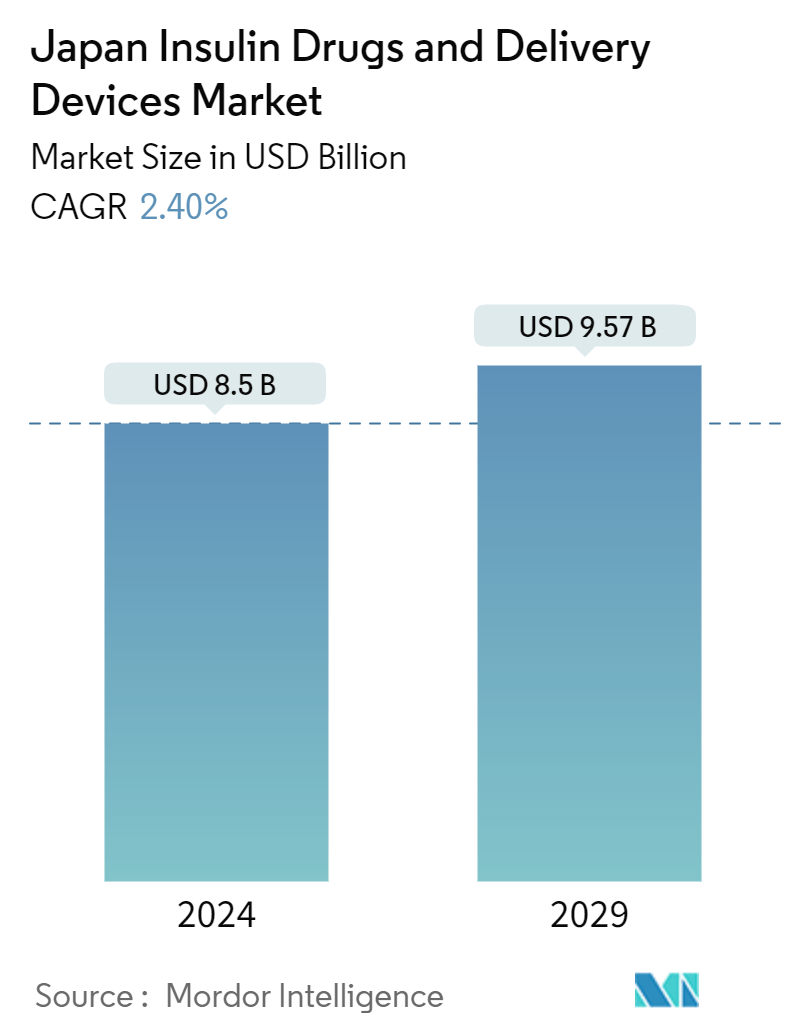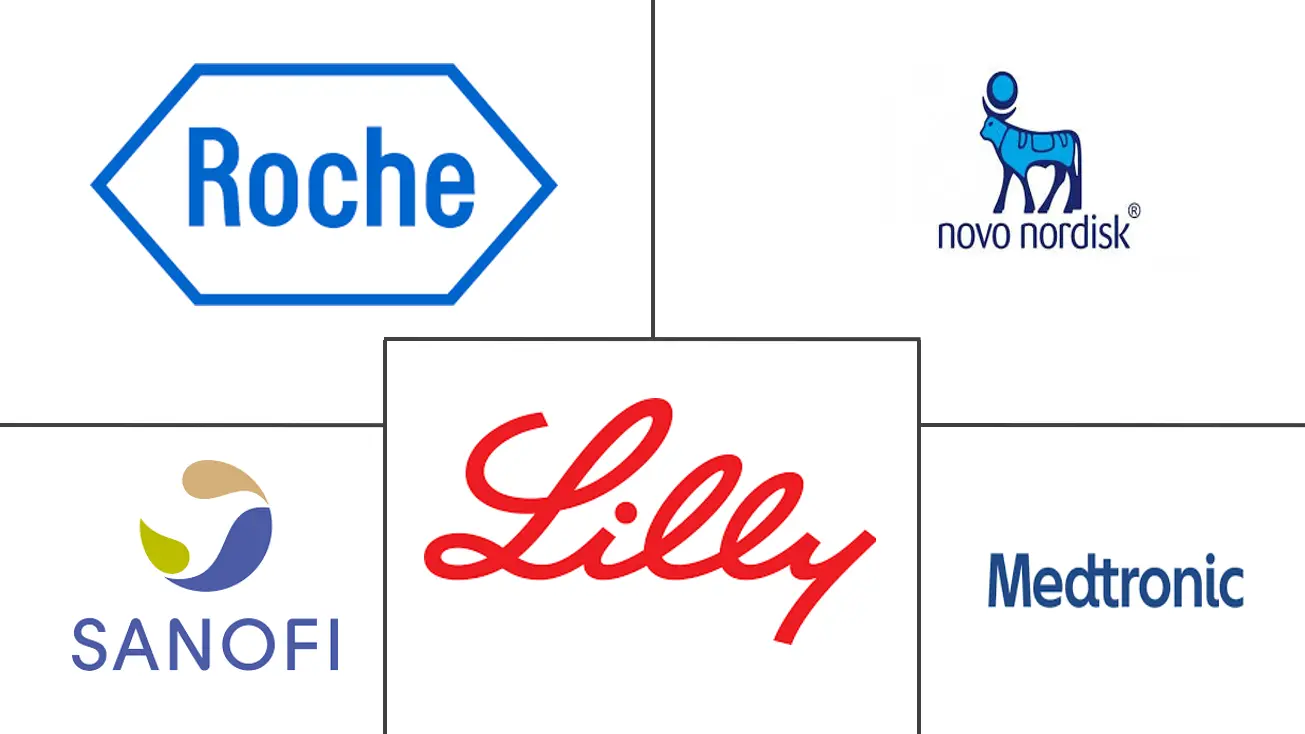Market Size of Japan Insulin Drugs And Delivery Devices Industry

| Study Period | 2019 - 2029 |
| Base Year For Estimation | 2023 |
| Forecast Data Period | 2024 - 2029 |
| Market Size (2024) | USD 8.5 Billion |
| Market Size (2029) | USD 9.57 Billion |
| CAGR (2024 - 2029) | 2.40 % |
Major Players
*Disclaimer: Major Players sorted in no particular order |
Japan Insulin Drugs And Delivery Devices Market Analysis
The Japan Insulin Drugs And Delivery Devices Market size is estimated at USD 8.5 billion in 2024, and is expected to reach USD 9.57 billion by 2029, growing at a CAGR of 2.40% during the forecast period (2024-2029).
In Japan, there has been a consistent increase in the number of individuals with diabetes who are using insulin medications and devices, aligning with the global trend of diabetes prevalence on the rise. The aging population and changes in lifestyle factors like diet and physical activity have contributed to a significant surge in diabetes cases, encompassing both type 1 and type 2 diabetes.
Type 1 diabetes, while less common than type 2 diabetes, affects a substantial portion of the population in Japan. These individuals depend on insulin medications to manage their condition, showing a preference for newer insulin formulations and delivery devices that offer enhanced convenience and accuracy in dosing. For instance, insulin pens have gained popularity among Japanese patients due to their user-friendly nature and discreetness, enabling more flexible insulin administration in various settings.
Moreover, the adoption of advanced insulin delivery devices such as insulin pumps and continuous glucose monitoring (CGM) systems is increasing in Japan. These technologies empower patients to have better control over their diabetes management by providing continuous insulin delivery and real-time glucose monitoring, ultimately aiding in optimizing blood sugar levels and reducing the risk of complications related to hypoglycemia and hyperglycemia.
Despite these advancements, challenges persist in ensuring equal access to insulin medications and devices for all individuals with diabetes in Japan. It is essential to address issues like financial barriers, healthcare infrastructure, and patient education to effectively manage the diabetes population and enhance outcomes in the country. Through ongoing efforts in research, healthcare policies, and public awareness, Japan is committed to advancing diabetes management and care for its population reliant on insulin medications and devices.
As a result of the aforementioned factors, the studied market is expected to grow during the analysis period.
Japan Insulin Drugs And Delivery Devices Industry Segmentation
Insulin drugs refer to medications that contain insulin hormone, which is used to manage blood sugar levels in individuals with diabetes. These drugs are primarily used in the treatment of type 1 diabetes, where the body produces little to no insulin, as well as in some cases of type 2 diabetes where insulin therapy is necessary. Insulin drugs come in various formulations, including rapid-acting, short-acting, intermediate-acting, and long-acting, each with different onset and duration of action to suit individual patient needs. Japan insulin drugs and delivery devices market is segmented into drugs, and devices. The report offers the value (in USD) and volume (in mL) for insulin drugs and (in unit) for the devices for the above segments.
| Drug | |||||||
| |||||||
| |||||||
| |||||||
| |||||||
|
| Device | |||||
| |||||
| |||||
| Insulin Syringes | |||||
| Insulin Jet Injectors |
Japan Insulin Drugs And Delivery Devices Market Size Summary
The Japan Insulin Drugs and Delivery Devices Market is experiencing a steady expansion, driven by the increasing prevalence of diabetes, particularly among the aging population. This growth is aligned with global trends, as lifestyle changes and an aging demographic contribute to a rise in both type 1 and type 2 diabetes cases. The market is characterized by a growing preference for advanced insulin formulations and delivery devices, such as insulin pens, pumps, and continuous glucose monitoring systems, which offer enhanced convenience and precision in diabetes management. These technologies are pivotal in helping patients maintain optimal blood sugar levels and reducing the risk of diabetes-related complications. Despite these advancements, challenges such as financial barriers and healthcare infrastructure disparities remain, necessitating ongoing efforts in research, policy, and public awareness to improve diabetes care in Japan.
The market landscape is consolidated, with key players like Novo Nordisk, Sanofi, Eli Lilly, Medtronic, and Roche actively participating in strategic partnerships and collaborations to enhance their market presence and product offerings. Initiatives such as the partnership between Health2Sync and Sanofi to digitize insulin management, and the collaboration between Terumo Corporation and Diabeloop to develop Automated Insulin Delivery solutions, highlight the industry's focus on innovation and expansion. The Japanese government's supportive healthcare policies, including comprehensive medical insurance coverage for diabetes care and the legality of self-injection insulin therapy, further facilitate market growth. As a result, the market is poised for continued expansion, driven by technological advancements and strategic industry collaborations.
Japan Insulin Drugs And Delivery Devices Market Size - Table of Contents
-
1. MARKET DYNAMICS
-
1.1 Market Overview
-
1.2 Market Drivers
-
1.3 Market Restraints
-
1.4 Porter's Five Forces Analysis
-
1.4.1 Bargaining Power of Suppliers
-
1.4.2 Bargaining Power of Consumers
-
1.4.3 Threat of New Entrants
-
1.4.4 Threat of Substitute Products and Services
-
1.4.5 Intensity of Competitive Rivalry
-
-
-
2. MARKET SEGMENTATION
-
2.1 Drug
-
2.1.1 Basal or Long-acting Insulins
-
2.1.1.1 Lantus (Insulin Glargine)
-
2.1.1.2 Levemir (Insulin Detemir)
-
2.1.1.3 Toujeo (Insulin Glargine)
-
2.1.1.4 Tresiba (Insulin Degludec)
-
2.1.1.5 Basaglar (Insulin Glargine)
-
-
2.1.2 Bolus or Fast-acting Insulins
-
2.1.2.1 NovoRapid/Novolog (Insulin aspart)
-
2.1.2.2 Humalog (Insulin lispro)
-
2.1.2.3 Apidra (Insulin glulisine)
-
2.1.2.4 FIASP (Insulin aspart)
-
2.1.2.5 Admelog (Insulin lispro Sanofi)
-
-
2.1.3 Traditional Human Insulins
-
2.1.3.1 Novolin/Mixtard/Actrapid/Insulatard
-
2.1.3.2 Humulin
-
2.1.3.3 Insuman
-
-
2.1.4 Combination Insulins
-
2.1.4.1 NovoMix (Biphasic Insulin aspart)
-
2.1.4.2 Ryzodeg (Insulin degludec and Insulin aspart)
-
2.1.4.3 Xultophy (Insulin degludec and Liraglutide)
-
2.1.4.4 Soliqua/Suliqua (Insulin glargine and Lixisenatide)
-
-
2.1.5 Biosimilar Insulins
-
2.1.5.1 Insulin Glargine Biosimilars
-
2.1.5.2 Human Insulin Biosimilars
-
-
-
2.2 Device
-
2.2.1 Insulin Pumps
-
2.2.1.1 Insulin Pump Devices
-
2.2.1.2 Insulin Pump Reservoirs
-
2.2.1.3 Insulin Infusion sets
-
-
2.2.2 Insulin Pens
-
2.2.2.1 Cartridges in reusable pens
-
2.2.2.2 Disposable insulin pens
-
-
2.2.3 Insulin Syringes
-
2.2.4 Insulin Jet Injectors
-
-
Japan Insulin Drugs And Delivery Devices Market Size FAQs
How big is the Japan Insulin Drugs And Delivery Devices Market?
The Japan Insulin Drugs And Delivery Devices Market size is expected to reach USD 8.5 billion in 2024 and grow at a CAGR of 2.40% to reach USD 9.57 billion by 2029.
What is the current Japan Insulin Drugs And Delivery Devices Market size?
In 2024, the Japan Insulin Drugs And Delivery Devices Market size is expected to reach USD 8.5 billion.

